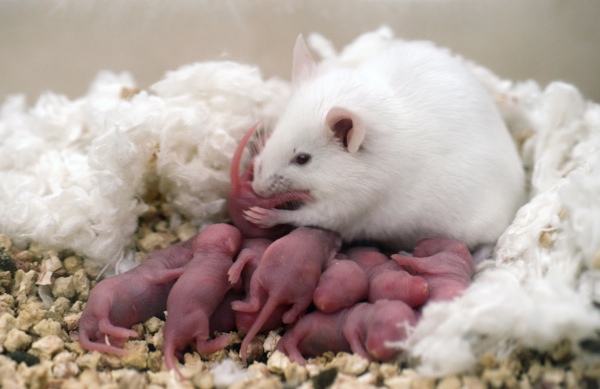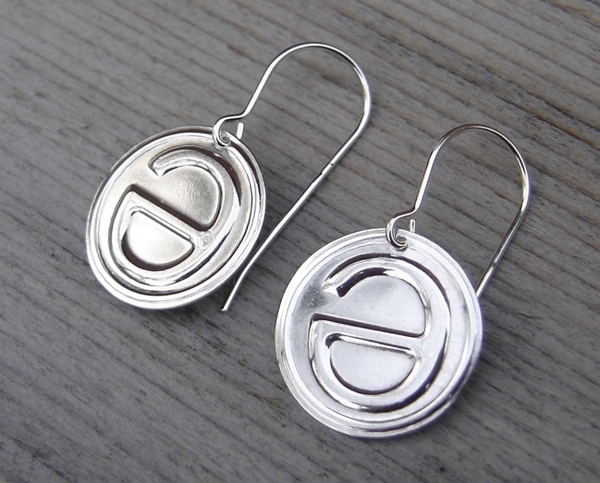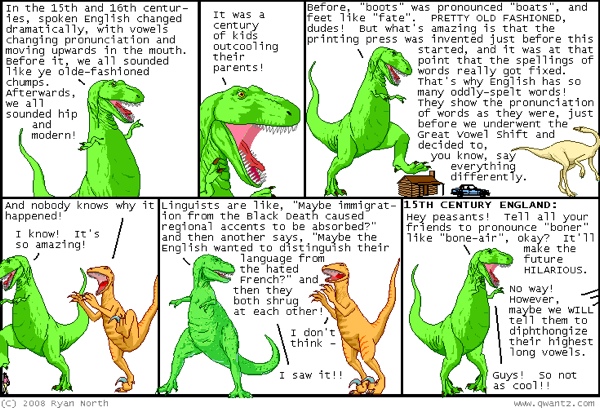 Technology
Technology  Technology
Technology  Humans
Humans 10 Everyday Human Behaviors That Are Actually Survival Instincts
 Animals
Animals 10 Animals That Humiliated and Harmed Historical Leaders
 History
History 10 Most Influential Protests in Modern History
 Creepy
Creepy 10 More Representations of Death from Myth, Legend, and Folktale
 Technology
Technology 10 Scientific Breakthroughs of 2025 That’ll Change Everything
 Our World
Our World 10 Ways Icelandic Culture Makes Other Countries Look Boring
 Misconceptions
Misconceptions 10 Common Misconceptions About the Victorian Era
 Mysteries
Mysteries 10 Strange Unexplained Mysteries of 2025
 Miscellaneous
Miscellaneous 10 of History’s Most Bell-Ringing Finishing Moves
 Technology
Technology Top 10 Everyday Tech Buzzwords That Hide a Darker Past
 Humans
Humans 10 Everyday Human Behaviors That Are Actually Survival Instincts
 Animals
Animals 10 Animals That Humiliated and Harmed Historical Leaders
Who's Behind Listverse?

Jamie Frater
Head Editor
Jamie founded Listverse due to an insatiable desire to share fascinating, obscure, and bizarre facts. He has been a guest speaker on numerous national radio and television stations and is a five time published author.
More About Us History
History 10 Most Influential Protests in Modern History
 Creepy
Creepy 10 More Representations of Death from Myth, Legend, and Folktale
 Technology
Technology 10 Scientific Breakthroughs of 2025 That’ll Change Everything
 Our World
Our World 10 Ways Icelandic Culture Makes Other Countries Look Boring
 Misconceptions
Misconceptions 10 Common Misconceptions About the Victorian Era
 Mysteries
Mysteries 10 Strange Unexplained Mysteries of 2025
 Miscellaneous
Miscellaneous 10 of History’s Most Bell-Ringing Finishing Moves
10 Tantalizing Tidbits About Vowels
Vowels are defined in two ways. Phonetically, a vowel is a speech sound made when the vocal chords vibrate and there is little or no obstruction anywhere along the vocal tract—the sound comes out free and clear. Vowels can also be understood as the symbol (letter) that represents the sound; English, for example, uses the following letters to represent vowels: a, e, i, o, u, and sometimes y (and, rarely, w). But English has far more vowel sounds than that—most American English dialects, for instance, have 15 to 16 vowel sounds in all. By contrast, with a few exceptions Spanish and Russian have fewer vowel sounds, which are generally pronounced in a manner consistent with their spelling.
Vowels have certain qualities than make them distinct, including length (short vs. long), position of the mouth and tongue, proximity to other vowels, roundedness of the lips, and nasalization. So let’s plunge headfirst into the deep waters of voweldom by answering these and more: Is it possible for a language to have no vowel sounds? What is a triphthong? Which language has as many as 55 vowel sounds? Are there any English words with no vowel sounds at all? What was The Great Vowel Shift?
Ubykh—sometimes spelled Ubyx—is a language whose last native speaker died in 1992. The language is part of the Northwest Caucasian Language group. The Ubykh people once lived in a place called Sochi, along the eastern shores of the Black Sea, until the Russians drove them out in the middle of the 19th century.
Tevfik Esenç—the last speaker of Ubykh—spent a great deal of time with linguists, in effect acting as the cultural and linguistic ambassador of a language soon on the cusp of extinction. Of the many fascinating properties of the language that were studied, perhaps this stands out the most: Ubykh has as few as two distinct vowels sounds. This is made all the more amazing when you consider that in contrast, Ubykh has one of the largest consonant inventories of any language ever observed, with between 81 and 84 consonant sounds—likely the most outside of the southern African Khoisan languages (which feature clicks). The disproportionate consonant-to-vowel ratio is the highest known in the history of the world’s languages.
It’s worth nothing that for a time, the Karbadian language of the Middle East (a language related to Ubykh) was thought to have only one distinct vowel sound. Some went even further, claiming it had no vowel sounds at all. It is now believed to have three vowels, and most linguists agree that no language will ever be found that does not contain any vowel sounds. The video above is of Tevfik Esenç reading a story in Ubykh.

Ah, the semivowel. Not quite vowelly enough to be a vowel, but not consonanty enough to be a full-fledged consonant, the semivowel lives in limbo. Phonetically, semivowels are known as “approximates,” a distinction they share with a few other types of sounds. English has two of these creatures: w and y. Make these sounds and it becomes clear why they fall someplace between vowel and consonant; there is some small obstruction, but the sounds emerge from the mouth in a manner quite similar to vowels. They are also known as “glides.”
In English spelling, y and w are semivowels when they begin words or are the first letter following a prefix, or (in the case of w only) when they follow a consonant. When they end words, however, they become part of the preceding vowel’s sound. Take the word “paw”—w does not act as a semivowel here, but rather serves to turn the “a” into a diphthong; similarly, the “y” to end “pay” does the same thing (See item 7).
If we approach these sounds from a phonological perspective—phonology being the study of how sounds construct meaning in language—some semivowels get more complex in an attempt to classify them. Vowels, by definition, are “syllabic:” on their own, they are considered a complete syllable. Y and w, however, are not —they must become attached to a vowel to attain true syllable status.

Syllables are a method of organizing and sequencing speech sounds; they’re the way we break down language into spoken parts. Syllables are generally divided into three parts: onset, nucleus, and coda. The nucleus and coda are frequently grouped together and called the rime. In the word “ten,” the “t” is the onset, the “e” is the nucleus, and the “n” is the coda—together, the “e” and “t” comprise the rime. In English, syllables are generally defined as needing a vowel as their nucleus (see #3), though some languages make use of a “syllabic consonant” at the nucleus of some syllables. English syllables may have an onset and rime (“cat”), an onset and coda (“me”), a rime only (“it”), or only a nucleus, without any onset or coda (this called a null-onset syllable), including the entire word “owe.” The word has three letters but only one sound, a diphthong that serves as a nucleus, whole syllable, and whole word. Certain languages require an onset, meaning that every syllable must begin with a vowel.
The word “rime” is used to describe the nucleus (with an optional coda) because of its direct ties to poetry. When rhyming words, it is the rime of the syllable that is used to produce the rhyming effect.

A diphthong is when two adjacent vowels come together to form a single vowel with two distinct elements. The vowel sound in the word “fight” is a diphthong, because you start with the vowel sound from “fa” and end up higher up in the mouth making the vowel sound from “feet.” English is full of diphthongs—the sentence “no highway cowboys” contains five distinct diphthongs. Note, however, the distinction between a diphthong and a situation where two vowels each retain their own full effect; the word “neon,” for instance, contains two separate syllables because the “e” and the “o” do not form a diphthong.
Similarly, a triphthong contains three vowel sounds all coming together to form one, as in the British pronunciation of the word “hour.” In this case, the first vowel is serving as the syllable’s nucleus, though there are languages where the second vowel does so and others where the third vowel does. There is some disagreement about whether the middle sound of a word like “layer” should be considered a triphthong, or two distinct vowel sounds (one being a diphthong). One of the reasons that English is tough for foreign learners is the relatively small extent of vowel movement—essentially, we slur our vowels together.

Apophony, sometimes used synonymously with the term “ablaut,” is a type of vowel gradation, which describes any pair of related words with differing vowel sounds. The first “o” in photograph is long, for example, whereas its counterpart in photography is short. In this pair, however, the grammatical information is intact; both words are nouns, and no inflection has taken place. Apophony, on the other hand, is a form of vowel gradation resulting in a grammatical change. In English, this occurs when the vowel in the middle of a word is altered either to pluralize the word or to change its tense.
A few examples:
– Sing/sang/sung/song. Here, we have 4 different vowels producing 4 distinctly different words, each conveying its own grammatical information (three verb tenses and a noun).
– Mouse/Mice. Phonetically speaking, the only difference here is a shift in the vowel between the “m” and “s” sounds—the result is a pluralization.
Sedang is a language with about 100,000 native speakers; it’s spoken in Laos and Vietnam and is in the Austro-Asiatic language family. More specifically, it belongs to the Bahnaric Language group, a collection of closely related languages known for their wide range of vowels.
What makes Sedang unique amongst the world’s languages is its sheer number of vowel sounds—some linguistic studies place this number as high as 55. The study of distinct vowel sounds is not an exact science, given how subtle the distinctions are between similar sounds—factors such as vowel length and quality contribute to the minor controversy of the “most vowels” crown.
Let’s break that vowel number down. Sedang has 24 pure vowels (meaning single vowels, not attached to another as a diphthong) which can be broken down into 7 vowels that can each be plain, nasalized, or “creaky“—a vowel quality produced by vibrating one’s vocal folds in such a way that the resulting sound is two octaves above its plain counterpart. Three of these vowels can be both nasal and creaky. Throw in a variable amount of diphthongs, and you’re left with a staggering array of vowel sounds.
As a noteworthy side note, the “creaky” quality of these vowels—also known as “vocal fry”—is possibly showing up in the speech patterns of American women, as well as certain dialects of the American Northwest. Listen to the Sedang language in the above clip.

If you think of the human mouth and its production of vowels as a 3-dimensional grid, what falls right smack in the center? It’s everyone’s favorite upside-down letter: the schwa, represented in the International Phonetic Alphabet as “?.” It’s the “uh” sound you hear at the beginning of the word “about,” and phonetically it’s described as a “mid-central” vowel. In English, it’s the most common vowel sound, showing up most commonly in unstressed syllables of words. The schwa can masquerade as any vowel in English:
The “a” in “sofa”
The “e” in photosynthesis
The “i” in “terrible”
The second “o” in “commonly”
The “u” in “medium”
The “y” in “syringe.”
Its use varies significantly based on which dialect of English is being spoken, though it almost always appears in unstressed syllables. In New Zealand English and South African English, however, the high front vowel in the word “sit” has shifted to a position in the mouth very close to the schwa—so close, in fact, that linguists generally denote its sound with a “?.”
In a phenomenon known as “schwa syncope” or simply “schwa deletion,” there is a situation in which schwas tend to be omitted from speech. When a schwa would normally be spoken in a syllable situated mid-word following the stressed syllable, it’s generally left out, as in the cases of cam(e)ra and choc(o)late. Note that schwa syncope does not exist in all English dialects.
Schwas are found in other languages as well, including Albanian, Romanian, French, Korean, and Hindi.

When we talk about words that have no vowels, there are two significantly different avenues for discussion: (1) Words without any vowel letters, and (2) words without any actual vowel sounds. In English, there are only a handful of vowel-less words from a spelling standpoint, and there is (surprise!) disagreement over whether any true English words have no vowel sounds.
Scrabble players, and people with a Welsh background, may recognize the Welsh loanword “crwth”—pronounced “cruth”—as a violin-like instrument. You’ll notice the use of “w” as a vowel here—evident in another Welsh example, cwm (“coom”), a sort of deep valley or gully within a mountain. Interjections like “shhh” and “hmm” have no vowel sounds, but are not always regarded as true words with distinct meanings. Other words like “nth” can stake a claim to be a vowel-less word, whereas words like “myth” don’t count because the “y” stands in for a short “i” sound.
English is usually classified as a language that requires a vowel for every word; by definition, an English syllable must contain a vowel. There are, however, possible exceptions—in certain dialects, for instance, one-syllable words like “bird” and “church” can be heard as having no vowel sound. Say the word “bird”—the “b” goes directly to the “r” potentially without a vowel as a go-between. Where this gets muddy is the concept of a “rhotic vowel” (represented here by the symbol [?]) which describes a vowel immediately before an “r;” the “r” sound affects the preceding vowel in a significant way. The word “bird” may thus, depending on analysis, be understood as containing an extremely short rhotic vowel.

As with #3 above, there is a difference between a written consonant and a spoken one. The word “eye,” for example, contains a written consonant—y—but is pronounced as one single diphthong. While we have a few such one-syllable words, English is a consonant-heavy language that requires them for nearly all words. Given that syllables do not require a consonant, certain languages have longer no-consonant words as well—unsurprisingly, English only contains a few (including “aa”) and they are all loanwords or scientific terms.
Many Polynesian languages, including Hawaiian, have dozens of such longer words, where the vowel syllables are separated by “glottal stops” (the brief disruption of airflow in the middle of “uh-oh”). One of these words is a small green fish called the “ae?ea,” which is also the name of the mythical land of Circe. Swahili, Finnish, Rapa Nui, and Portuguese are other languages with longer consonant-less words.

Giving The Great Vowel Shift such cursory treatment is to redefine “short shrift,” and it deserves its own list at the very least. But we’ll summarize it the best we can: The Great Vowel Shift is the name of a massive change in English pronunciation that took place over a period of several hundred years spanning the 15th through 18th centuries. In essence, long vowels began to shift “upwards” in their positioning in the mouth; long vowels already at the top had noplace higher to go, and became diphthongs. This dramatically affected the way English is pronounced today, and is partially responsible for English’s confusing spelling system.
The modern English word “ripe” was once pronounced “reep;” say the two in succession and you can feel your tongue shifting to produce a vowel sound in different parts of the mouth. The word “house,” which features a diphthong, was once pronounced something like “hoose”—a long vowel already toward the top part of the mouth. In all, five long vowels shifted upwards, and two others became diphthongs. Notable exceptions to the Great Vowel Shift help explain some of the many English spelling inconsistencies; take the word “broad,” which one might expect to rhyme with “road” and “toad.” Somehow, “broad” and other words (particularly ones with the “ea” spelling) escaped the Shift.
As with all language events that cannot be directly studied (we have plenty of text from the time period, but no audio), linguists and historians disagree on the causes of the Shift. Theories include accent shifts following the great post-Black-Death migrations; others look to differences in social classes.